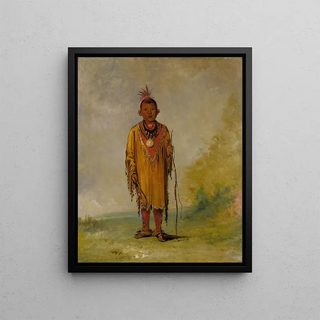Art print Me-su-wahk Deer's Hair Fils préféré de Kee-ok-k - George Catlin | Art print


View from behind

Frame (optional)
Reproduction of Me-su-wahk Deer's Hair Fils préféré de Kee-ok-k - George Catlin – Captivating introduction
In the rich and complex universe of art history, certain works stand out for their ability to capture the essence of a culture and a period. The art print of Me-su-wahk Deer's Hair Fils préféré de Kee-ok-k - George Catlin is one of these iconic pieces. It embodies not only the undeniable talent of its creator but also a poignant vision of the Native American world in the 19th century. Through this piece, Catlin invites us to delve into a visual narrative that resonates with the traditions and values of the peoples he encountered. This canvas is much more than a simple representation; it is an open window to a often little-known past.
Style and uniqueness of the work
George Catlin's style is characterized by a unique approach that combines precision and expressiveness. In the art print of Me-su-wahk Deer's Hair Fils préféré de Kee-ok-k, every detail is carefully rendered, from the delicate features of the face to the traditional ornaments adorning the characters. Catlin managed to capture not only the physical appearance of his subjects but also their soul, their history, and their culture. The vibrant colors, often inspired by natural pigments, add an almost living dimension to his works. The composition, balanced and harmonious, guides the viewer's gaze through the scene, revealing layers of meaning and emotion. This artistic approach makes Catlin a pioneer in the representation of indigenous cultures, at a time when these were often stigmatized or misunderstood.
The artist and his influence
George Catlin, born in 1796, is an artist whose work transcends the simple frame of painting. As an ethnographer and advocate for the rights of indigenous peoples, he dedicated his life to documenting the lifestyles of the tribes he encountered during his travels across the United States. His commitment to truth and authenticity is palpable in each of his canvases. Catlin not only created a vast collection of works but also was a fervent defender of the preservation of Native American cultures, opposing their forced assimilation. His influence endures

Matte finish

View from behind

Frame (optional)
Reproduction of Me-su-wahk Deer's Hair Fils préféré de Kee-ok-k - George Catlin – Captivating introduction
In the rich and complex universe of art history, certain works stand out for their ability to capture the essence of a culture and a period. The art print of Me-su-wahk Deer's Hair Fils préféré de Kee-ok-k - George Catlin is one of these iconic pieces. It embodies not only the undeniable talent of its creator but also a poignant vision of the Native American world in the 19th century. Through this piece, Catlin invites us to delve into a visual narrative that resonates with the traditions and values of the peoples he encountered. This canvas is much more than a simple representation; it is an open window to a often little-known past.
Style and uniqueness of the work
George Catlin's style is characterized by a unique approach that combines precision and expressiveness. In the art print of Me-su-wahk Deer's Hair Fils préféré de Kee-ok-k, every detail is carefully rendered, from the delicate features of the face to the traditional ornaments adorning the characters. Catlin managed to capture not only the physical appearance of his subjects but also their soul, their history, and their culture. The vibrant colors, often inspired by natural pigments, add an almost living dimension to his works. The composition, balanced and harmonious, guides the viewer's gaze through the scene, revealing layers of meaning and emotion. This artistic approach makes Catlin a pioneer in the representation of indigenous cultures, at a time when these were often stigmatized or misunderstood.
The artist and his influence
George Catlin, born in 1796, is an artist whose work transcends the simple frame of painting. As an ethnographer and advocate for the rights of indigenous peoples, he dedicated his life to documenting the lifestyles of the tribes he encountered during his travels across the United States. His commitment to truth and authenticity is palpable in each of his canvases. Catlin not only created a vast collection of works but also was a fervent defender of the preservation of Native American cultures, opposing their forced assimilation. His influence endures
12,34 €






